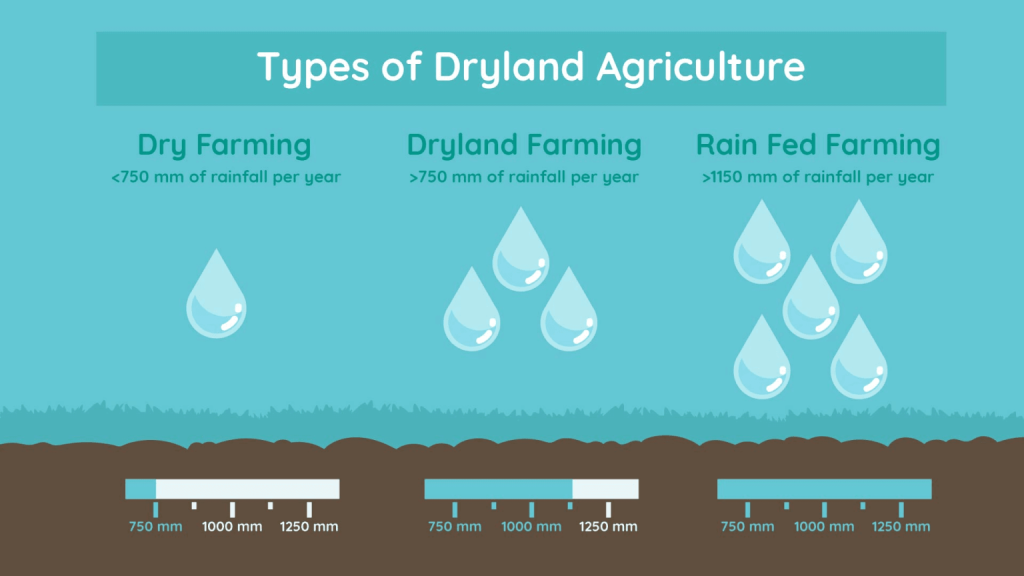What is Dryland Farming – Know Everything
Introduction to Dryland Farming
Dryland farming is a method of agricultural production that relies on rainfall as its primary source of water, without the aid of irrigation systems. Practiced predominantly in arid and semi-arid regions, this approach is essential for maximizing crop yield in areas where water resources are scarce. Dryland farming techniques are tailored to cope with limited moisture availability, making it a cornerstone of sustainable agriculture in challenging environments.
Characteristics of Dryland Farming
- Dependence on Rainfall:
- The success of dryland farming hinges on the effective utilization of seasonal rainfall. Farmers often plan crop cycles around predictable rain patterns to optimize growth and yield.
- Use of Drought-Resistant Crops:
- Crops such as millet, sorghum, chickpeas, and certain varieties of wheat are common in dryland farming. These crops are adapted to withstand low moisture conditions.
- Minimal Use of Irrigation:
- Unlike irrigated farming, dryland farming minimizes water usage, conserving resources and reducing environmental impact.
- Soil Management:
- Farmers employ techniques like mulching, contour plowing, and crop rotation to retain soil moisture and maintain fertility.
Regions Suitable for Dryland Farming
Dryland farming is widely practiced in regions with annual rainfall between 250 and 500 millimeters. Key areas include:
- India: Rajasthan, Madhya Pradesh, and parts of Andhra Pradesh.
- United States: The Great Plains region.
- Australia: Southern and western parts.
- Africa: Sahel and parts of East Africa.
Techniques and Practices in Dryland Farming
- Moisture Conservation:
- Techniques like deep plowing and creating ridges help in retaining soil moisture.
- Crop Diversification:
- Growing a mix of crops reduces the risk of total crop failure and optimizes resource use.
- Weed Management:
- Timely removal of weeds minimizes competition for water and nutrients.
- Time of Sowing:
- Planting crops at the right time ensures maximum utilization of available moisture.
- Soil Fertility Maintenance:
- Organic manures, green manure, and crop residues are often used to replenish soil nutrients.
Benefits of Dryland Farming
- Environmental Sustainability:
- Reduced dependency on irrigation conserves water resources and minimizes ecological disturbances.
- Cost Efficiency:
- The limited use of external inputs such as water and fertilizers lowers production costs.
- Adaptability:
- Dryland farming practices are adaptable to various climatic conditions, making it a resilient agricultural approach.
- Promotion of Indigenous Crops:
- It encourages the cultivation of local crops that are naturally suited to the region’s climate and soil.
Challenges in Dryland Farming
- Unpredictable Rainfall:
- Variability in rainfall patterns can lead to inconsistent yields.
- Soil Degradation:
- Overuse and lack of proper management can lead to soil erosion and loss of fertility.
- Low Productivity:
- Yields are often lower compared to irrigated farming due to limited water availability.
- Pest and Disease Control:
- Dryland crops may be more susceptible to pests and diseases, requiring careful monitoring.
Advancements in Dryland Farming
- Technology Integration:
- Use of modern tools like drones and satellite imaging helps in better planning and monitoring of fields.
- Improved Seed Varieties:
- Development of genetically engineered drought-resistant seeds enhances productivity.
- Water Harvesting:
- Techniques like building farm ponds and check dams improve water availability during dry spells.
- Government Initiatives:
- Subsidies, training programs, and research funding help farmers adopt better practices.
Case Studies of Successful Dryland Farming
- Rajasthan, India:
- Farmers in Rajasthan use traditional water conservation methods like tankas and khadins to practice dryland farming effectively.
- Australia’s Wheat Belt:
- Advanced soil management and water conservation techniques have made Australia’s wheat belt a global leader in dryland farming.
- The Sahel, Africa:
- Agroforestry and the integration of native plant species have improved soil fertility and moisture retention in the Sahel region.
Future of Dryland Farming
With climate change intensifying water scarcity issues, the importance of dryland farming is set to grow. Future strategies include:
- Increased research into climate-resilient crops.
- Enhanced adoption of precision farming technologies.
- Greater global collaboration for sharing knowledge and best practices.
Conclusion
Dryland farming is a vital agricultural practice that sustains millions of farmers and contributes to global food security. Despite its challenges, innovations in technology, coupled with traditional wisdom, hold the promise of transforming dryland farming into a more productive and sustainable endeavor. By understanding and addressing its intricacies, societies can ensure a stable and resilient agricultural future.


